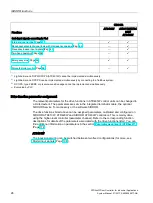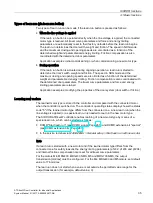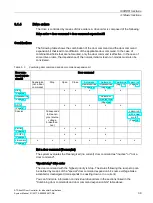
SIDOOR functions
3.1 Basic functions
ATD4xxW Door Controller for Industrial Applications
42
System Manual, 01/2017, A5E38080677-AB
Prioritization of door command sources
Door commands can be issued via different sources. A higher-priority drive order overwrites
a lower-priority drive order. The service interfaces generally have the highest priority
because they are intended for commissioning and service purposes.
Table 3- 6
Prioritization of door command sources
Priority
Door command source
Remarks
High
1. Service buttons S401, S402 and S403
Commands issued locally on the controller
2. Software Kit (PC) and Service Tool or local
terminal
Commands issued locally via the service terminal or the
PC tool
3. Process data
(USS, PROFIBUS, PROFINET)
FBLOCK system
(digital INPUT1, 2, 3, 4 and X5)
Drive orders are mutually prioritized
Low
4. FBLOCK system
(edge-controlled drive orders "latched")
Only in the case of edge-controlled digital input signals of
the FBLOCK system (latched drive orders)
Mutual prioritization of door commands
When a command is issued via the process image, there can be no mutual prioritization of
door commands because the corresponding DCMD signal is based on an enumerative
structure and therefore only ever one door command can be active. Prioritization is applied
in the case of interconnections within the FBLOCK system or the service buttons, for
example.
Table 3- 7
Prioritization of the door commands
Priority
Door command
Remarks
High
1. Stop
The source voltage brake is deactivated after the ramp stop via the "special"
expansion bit
→ coasting down/deenergized with highest priority
2. Open
3. Close
4. Automatic AssistedDrive,
Automatic ImpulseDrive,
Positioning
Same priority
(internal processing sequence determines the drive order)
5. Learn run
Learn run can be interrupted
Low
6. Deenergize
Neutral door command corresponds to the idle state, equivalent to inactive
→ coasting down/deenergized with high priority via "special stop" drive order















































